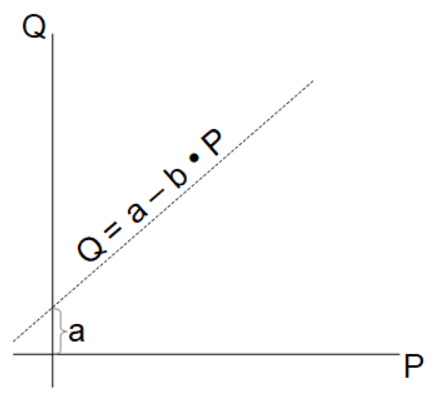Tags | |
The Linear Demand Curve calculator computes the Quantity of Demand (Q) based on the general effects on quantity of demand other than price (a), the slope of the effect of price changes on demand (b) and the price (P).
INSTRUCTIONS: Enter the following:
- (a) Effect of all influence on demand other than price.
- (b) Slope of the effect on demand on changes in price.
- (P) Price of goods.
Quantity of Demand (Q): The calculator returns the quantity
The Math / Science
The formula for the Linear Demand Curve is:
Q = a - b•P
where
- Q is the quantity of demand
- a is the effect of all influences on demand other than price
- b is the slope of the demand in relationship to the price (P)
- P is the price
[From WikiPedia] The demand curve is often graphed as a straight line of the form Q = a − b•P where a and b are parameters. The constant "a" embodies the effects of all factors other than price that affect demand. If income were to change, for example, the effect of the change would be represented by a change in the value of "a" and be reflected graphically as a shift of the demand curve. The constant "b" is the slope of the demand curve and shows how the price of the good affects the quantity demanded.
Micro Economics Calculators
- Least-squares Trend Line (linear regression)
- Basic Price Elasticity of Demand.
- Midpoint Method of Price Elasticity of Demand
- Midpoint Method of Price Elasticity of Demand with automatic Quantity Unit Handling:
- Cobb Douglas Utility Maximizing Consumption Bundle
- Statistics Calculator
- Stats Basics Calculator
- Production and Consumption Rate Calculator
- Income Elasticity of Demand
- Cross-Price Elasticity of Demand
- Price Elasticity of Demand
- Price Elasticity of Supply
- Total Surplus
- Consumer Surplus
- Producer Surplus
- GDP Growth
- GDP Deflator
- GDP by Income
- GDP Expenditure
- Net Capital Outflow
- Net Exports and Net Capital Outflow
- Dollar Conversion from Different Times
- Unemployment Rate (Friedman and Phelps)
- National Saving
- Domestic Investment
- Unemployment Rate
- Inflation Rate in Year 2 (using CPI)
- Labor Force
- Labor-Force Participation Rate
- Net Exports
- Real Exchange Rate
- Currency Converter
- Midpoint Method for Price Elasticity of Demand
- Income Elasticity of Demand

